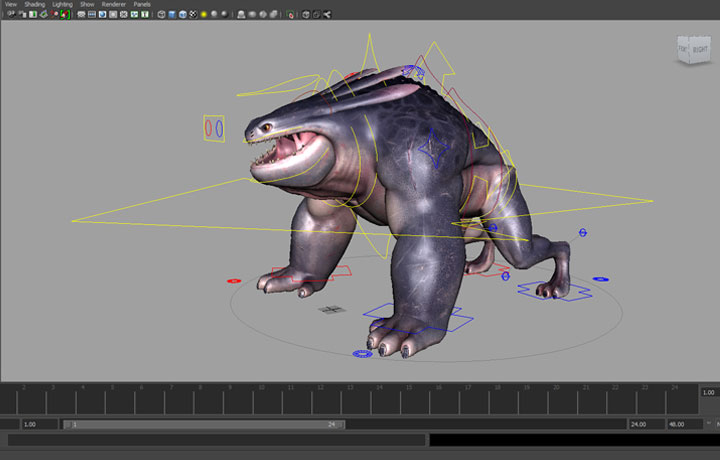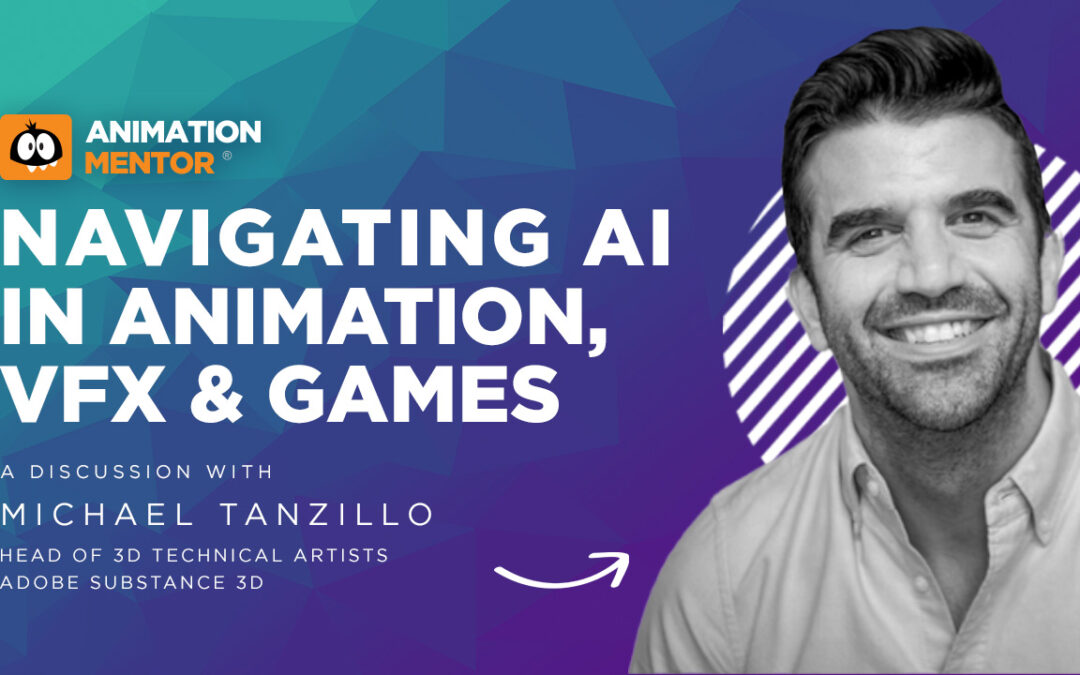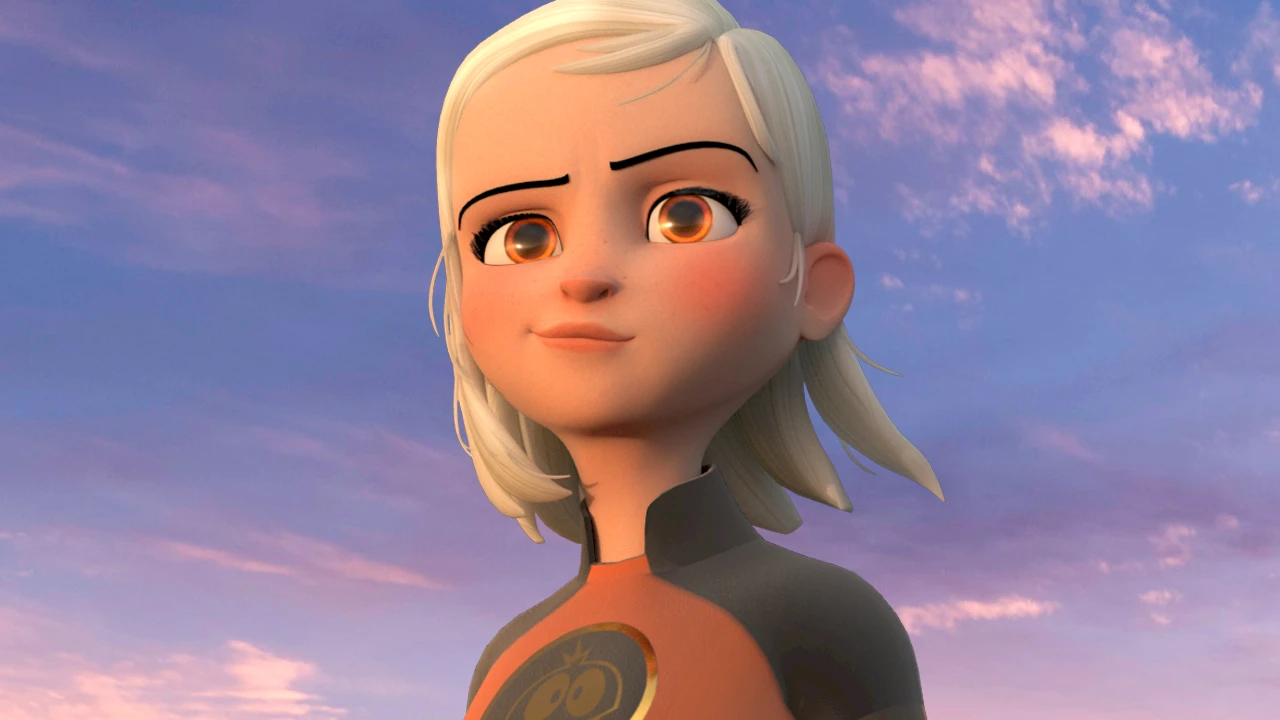
Carlo rigged both Animation Mentor’s Dozer and Hatch Characters. Dozer is pictured above.
Animation Mentor’s latest quadruped characters, Dozer and Hatch, were rigged by the amazing rigger Carlo Sansonetti. Carlo’s expertise in rigging has allowed both Dozer and Hatch to be bad-ass quadrupeds ready to take on any story an animator can imagine. In today’s blog, Carlo shares his insights as to what a rigger must keep in mind while rigging a character for 3d animation.
– The Animation Mentor Crew
———————–
- Talk to the Designer, Modeler, and Animator
- What is the purpose of the character
- Why did you make certain design choices
- What was the reason behind their certain edge looping choice
- How is the character going to be “pushed”
- List all the things the character is going to do in its performance
- Think of your customer: the animator
- Precision in your work: small errors build up, so keep testing your rig
- Ease of Use vs Rig Complexity
- “Is this feature going to be easier for the animator to use?”
- “If I need to fix this later, is it going to be easy for me to fix?”
- Name your nodes properly
- Keep your scene organized
- Keep referring to your reference
- Shortcuts are almost never time savers
- Always think at how the character will be used.
Even before you start rigging, I always recommend you to talk to the Designer, Modeler and Animator of the character. If you don’t have access to these people, go through the mental process of asking the following questions to yourself and try to answer them the best you can.
Designer:
Modeler:
Animator:
By going through the process of asking these questions you will become more knowledgeable about the character, which will allow you to concentrate on the things that matter about the character. Asking these questions will also help you come up with ideas of your own that will eventually make the character as believable as possible.
When you rig a character, always keep in mind that the rig is a tool that the animators are going to use every day for potentially several weeks or months in order to do their job well. A rig is to an animator what a model is to a rigger, so think how much fun and rewarding it is to work with a great model instead of with a poor one. A model with good edge loops, will make your job easier and more enjoyable, the same way an animator will have fun with a simple but powerful rig. The challenge for you as a rigger will be to find the right balance between rig flexibility and ease of use.
When you are rigging a character by hand (i.e. without a script), always keep in mind that if you see yourself making a mistake, even an infinitesimally small one, that mistake is going to be compounded with other small mistakes you make during the rigging progress. So much so that by the time the rig is complete, these small errors will accumulate and become much more noticeable.
Always try to place your nodes mathematically correctly and keep testing your rig as you build it to minimize problems down the line.
If you are at crossroads and need to make a decision about implementing a really cool rig feature, always ask yourself these 2 questions:
The second question is sometimes overlooked, but keep in mind that rigging a character does not only mean creating a rig, but it also means maintaining it.
With rigging, it is extremely important to name your nodes correctly every time you create a new one. Name them in a way that makes sense to you or your team. If not implemented already, have a naming convention that works for you and follow it 100%.
During the rigging process, you will create many nodes that are not visible to the animator and a lot of times, the tendency is not to name these nodes. This is a huge mistake because you will have a hard time debugging problems later on if nodes are not named in a way that
makes sense.
It is very important you always keep your scene organized. Think of your scene as your desk. If you have things scattered on your desk, they will be difficult to find.
Whenever you show the rig to an animator, or to another rigger, even if the rig is in a very early stage, always clean your scene up. In other words avoid having all sorts of nodes sitting in your outlines not organized, as this can make it difficult for the animator to test your rig. Think of it as a presentation. Every time you show your rig to someone else, (and hopefully you will do this often), always clean up your scene and organize it.
When rigging a character it is very easy to get tunnel vision. So try to step back and look at the reference that you started with and see if what you are doing is accurately portraying what the reference is telling you. If not, course-correct early.
If you are thinking of taking the easy way out with a certain rigging problem, it’s almost never
a time saver. The most important thing to always keep in mind is to make sure the rig is going to be able to perform the way it is supposed to. If you try to cut corners in this department, it will often bite you later.
When rigging a character, always keep in mind the way the character is going to be used in your production. You might be rigging some characters that are only seated. If that’s the case, try not to spend too much time trying to make the rig deform well when the character is standing. Try to tailor your rig to what the character is going to do in the show.
On the other hand if there is any doubt regarding how the character is going to be used, then expect anything and rig the character in a way that can be pushed in all directions.
———————
Carlo Sansonetti is a veteran character rigger with who has worked on the TV show, Star Wars: The Clone Wars (Lucasfilm) and developed rigging for Heavy Iron Studios. He is also the president and cofounder of CG Circuit, an online platform for sharing knowledge about the CG pipeline.




